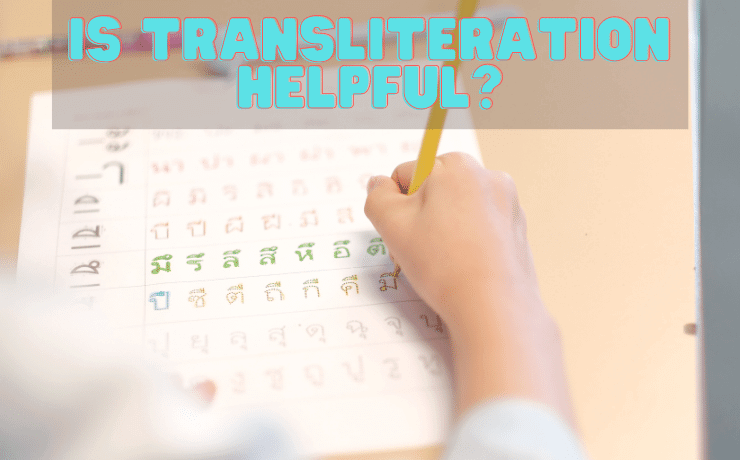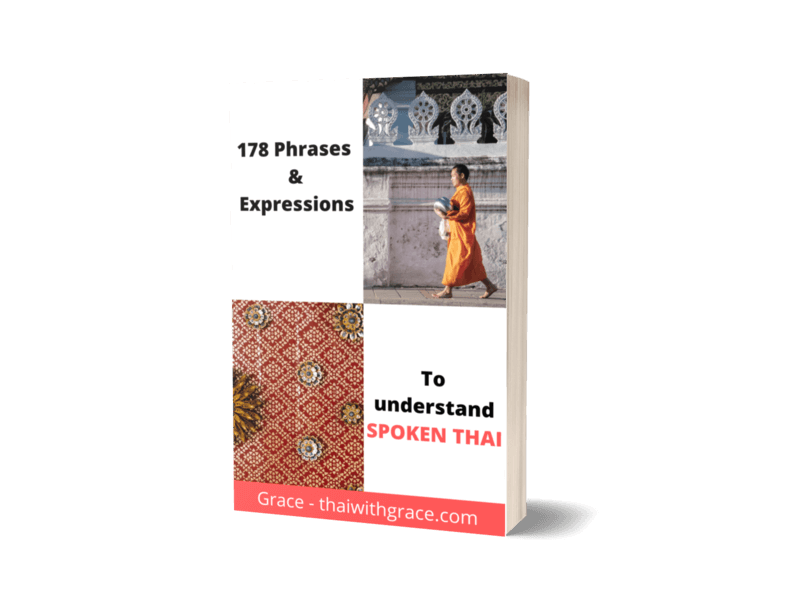Learning to read Thai characters is a challenge. Because of this, many Thai learners try to avoid learning to read and instead use the English alphabet to write down Thai words.
For example, instead of สวัสดี (the word for “hello”) they will write down sawatdee (or something like this).
While this can help you in the beginning to memorize words in the short term, you will find out that relying on transliteration will actually hurt you in the long term.
My number 1 piece of advice is to learn to read Thai with the Thai characters.
Let me explain why.
You can also watch the above video explanation and download the transcript for the video here.
Which version of the transliteration is correct?

I’ve had students ask me the following:
“I find confusing how people use many different spellings for the
same words.
For example: Sawadee, sawaddee, sawasdee, sawatdii, swasdi…
which one is correct? Can I use all of them?
What about this one? I am a man so I say: Sawasdee Krab, is it krab?
krap? krub? krhup? or krhub?
Very confusing for me as I am only just starting to learn your
language.”
The answer is, unfortunately, no version is correct. Thai people use Thai characters. You will never see a Thai person use transliteration to write something. If they do, it’s just to show a foreigner how it sounds like, but there is no “standard” way.
So from the above example, a few of the spellings technically get you “close” to the real sound. In my opinion, they are Sawadee, sawaddee, sawatdii.
If you tried pronouncing all those, you would get close to the real sound, so how you spell it is really up to you.
So why do some people write sawasdee?
So why do some people write sawasdee? This is because these technically are also correct if you spell out each letter literally how they sound like.
Let’s break down “สวัสดี“. “ส” makes a “s” sound. “ว” makes a “w” sound. “อั” makes a “a” sound. “ด” makes a “d” sound. And “ อี” makes a “ee” sound. So put it all together, and you get sawasdee. The problem is that “ส” at the end of a syllable makes a “d” sound (hence sawaddee).
So why do some people write swasdi?
So what about swasdi? Why do some people write “swasdi“. This is because in this part: สวั there is no “a” in between “ส” and “ว“. However, in this case, an “a” sound gets added. Hence, the real pronunciation is closer to “sawatdee” if I absolutely had to spell it.
What about krab, krap, krub, krhup, or krhub? – which one is correct?
As far as (ครับ) Krap, I have also seen all those spellings online, and once again, it depends on how your mind thinks to write the sound. To me, it’s closer to “krap”, but unless you learn to read Thai, it’s up to interpretation.
Thai also has short and long vowels, so if you say “krap” but hold the “a” a bit too long, it’s incorrect. Which once again leads me to the point that only learning to read Thai is correct.
So if you see many variations for the same words, keep in mind it’s all up to interpretation. Learn to read as quickly as possible, and you won’t have to worry about this.
So which version is correct? None. Different people write different things.
Thai has more/different sounds than English.
If you use transliteration, you will see there are a few sounds that are just very difficult to write in English. – Meaning if you ask 3 people to pronounce something written in transliteration, all 3 people will pronounce it differently.
For example, ก็เลย (meaning “therefore”) – you might spell it as gor loiie, go loey, go loei, etc. The sound this word makes isn’t found in any word in English, making it hard to write transliteration for.
Another very simple example is the word for hands “มือ“. The vowel “อือ” is commonly transliterated as “eu“. But besides “meu”, I’ve seen “mew” too. I bet if you don’t know Thai and you try to pronounce “meu” or “mew” , you will pronounce something totally wrong.
Thai has short and long vowels
As I mentioned before, Thai language has long and short vowels. So how do you signify a longer vowel? Some people just write the vowel in English twice. i.e dog = “maa” and not “ma“.
Take the Thai word for “you” (คุณ). I’ve seen spellings such as kun, koon, kon. Which one to use?
This works, but it can get confusing. Take the Thai word for “you” (คุณ). I’ve seen spellings such as kun, koon, kon. Which one to use?
Let’s break it down. The “อุ” is a short vowel with a sound like the “oo” in balloon. But if you write koon, you might think it’s a long vowel and pronounce it for longer than you have to, turning it into another word (such as the Thai word for multiplication = คูณ). But, if you write “kun”, you might pronounce it like the “un” in the English word “bun”, which is also wrong.
Nothing is standardized
Unlike Chinese, which has pinyin, in Thai, there is no standard.
I also think that if there was a standard, it shouldn’t be used. This is because Chinese uses symbols to represent words, Thai does not. So the pinyin represents the sounds. But for Thai, the Thai characters represent the sound, so If you learn to read Thai, you will know exactly how to pronounce the word.
Also, learning to read Thai, although challenging, can be done in a short period of time. Instead, learning all the Chinese symbols can take a long time.
This is because there is no standard.
This is why, as you’ve noticed, some sites use a different form of transliteration compared to others. This is because there is no standard.
For example, take a look at this picture from 4 different transliteration/sites. All of them write the English transliteration differently. It’s for the Thai word for a “Film” (ภาพยนตร์).

Most Thai people don’t know transliteration. Also, Thai has tones
In Thailand, you are never taught English transliteration. There are no websites or books for Thai people using English transliteration.
Therefore unless it’s a very simple example to guess, Thai people won’t understand transliteration.
Also, since Thai has tones, it would be hard to represent the tones.
Say you just started learning Thai and heard the word “ม้า” (meaning “horse”). You write to your Thai friend, what does “ma” mean?
Your Thai friend might guess horse or dog or come. Instead, if you learn to read Thai and listen to the tones, you’d have a better chance of spelling it correctly.
You will learn slower
At first, it may seem like you can learn faster when learning with transliteration. This is because you don’t have to memorize all these new letters, vowels, consonants, or tone rules.
However, you will quickly stall and find it difficult to progress if you don’t learn to read Thai.
If you don’t learn to read Thai,
- you’ll never find authentic Thai materials you can study from.
- You won’t be able to read Thai books, browse Thai sites, etc.
- It will also be difficult for you to learn the rules required to pronounce words correctly.
Summary
To summarize, all transliteration for Thai is incorrect. This is because there is no standard version, and all transliteration is up to your interpretation. You will see all kinds of transliteration online.
So don’t be surprised when you see the same word spelled in different ways.
I recommend you learn to read Thai and then you won’t face this problem.
I hope this article helps you understand why I don’t think learning Thai using transliteration is helpful, and why you should study to quickly not depend on it.

